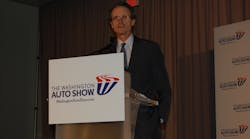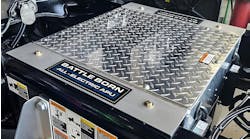WASHINGTON D.C. Even though the Environmental Protection Agency (EPA) is still in the midst of a “mid-term evaluation” of its light-duty vehicle fuel economy and greenhouse gas (GHG) rules that run out until 2025, Assistant Administrator Bill Wehrum said those rules are helping deliver significant long-term improvements in fuel economy.
“In 10 out of the last 12 years, fuel economy has increase for light vehicles and has increased 22% since 2004,” he said during a press conference here at the 2018 Washington Auto Show.
Wehrum noted that overall light-duty vehicle fuel economy inched up 0.1 miles per gallon (mpg) to 24.7 mpg in 2016 versus 2015. Sport utility vehicles (SUVs), which now account for 41% over overall light-duty vehicle sales, recorded a fuel efficiency jump of 1.1 mpg in 2016, while truck-based SUVs gained 0.3 mpg, in 2016 vs. 2015 comparisons.
“We’re seeing the rapid adoption and dissemination of new technologies to enable this,” he added. “Direct fuel injection, for example, is expected to be on 50% of vehicles for 2017, with continuously variable transmissions (CVTs) and seven-speed transmissions each at 25%. We only dreamed of such [technological] developments just a few short years ago.”
Going forward, as EPA re-evaluates the future direction of those standards, Wehrum said that two of the agency’s primary focal points when it comes to motor vehicle regulations.
The first it to maintain what he called a “national program” that aligns the rulemaking efforts of EPA, the National Highway Traffic Safety Administration (NHTSA) and the California Air Resources Board (CARB) so fuel economy regulations are “consistent” across the country.
The second is to ensure that any future rulemaking effort pertaining to fuel economy is based on the “technical merits” of any proposal.
“It’s about overlaying public policy on top of sound engineering,” he explained. “We have to ensure what we do is based on good engineering and science.”
That philosophy is also going to be put to the test on the heavy-duty side of the GHG rulemaking playbook.
While Wehrum said there is “not much yet to say” on EPA’s heavy-duty vehicle regulatory focus – “in a lot of ways we are only really getting started here,” he emphasized – he noted that the agency “has heard loud and clear from the OEMs” that there needs to be a fresh look at revising and updating those rules.
“This is a unique case where the industry being regulated wants to be regulated,” he said, largely because “it is helpful to have certainty with a long time line for rules set to take effect in the future.”



